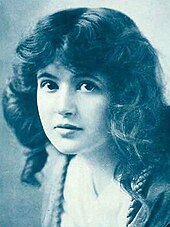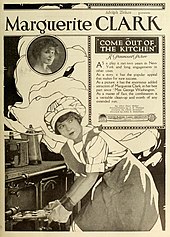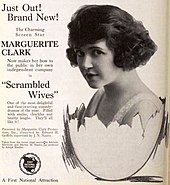Marguerite Clark
Helen Marguerite Clark (born February 22, 1883 in Avondale , Ohio , † September 25, 1940 in New York City ) was an American actress . In her career, which lasted from 1900 to 1921, she was seen as a leading actress in 40 films and was at times after Mary Pickford as the most popular film actress in the United States. Clark also worked as a stage actress on Broadway . Most of her cinematic works are now considered lost or destroyed.
Life
Marguerite Clark grew up as the third child of Augustus and Helen Elizabeth Clark in their birthplace Avondale. Her mother died in January 1893 when Marguerite was nine years old. The father, who worked successfully as a self-employed gentlemen's outfitter , then raised the children on his own before he also died in December 1896. Clark's older sister Cora then took over her guardianship and sent her from a public school to the Ursuline Academy, a Catholic girls' school in Cincinnati .
After graduating from high school at the age of 16, Clark decided to pursue an acting career. In 1900 she made her first appearance on Broadway in New York. After comedic roles, Clark was seen in pieces of the fantasy genre, which brought her greater notoriety and became her trademark. With The Wishing Ring (1910) and The Affairs of Anatol (1912) she appeared in two theater productions by Cecil B. DeMille .
In 1914 Marguerite Clark made her film debut in Wildflower . At 31, she entered Hollywood relatively late. Similar to her fellow actor Mary Pickford, who was a year older, Clark had a very young appearance that allowed her to continue to play the roles of girls or teenagers. Her best-known roles included that of Snow White in the first feature - length version of the classic fairy tale in 1916 by James Searle Dawley . In 1918, Clark played both Little Eva St. Clair and Topsy in an early production of Uncle Tom's Cabin . Most of her films are now considered lost or destroyed. This was due to the highly inflammable celluloid film used at the time , which fell victim to poor storage.
Marguerite Clark was considered the most popular silent film star in the United States after Mary Pickford. A kind of "friendly rivalry" was described between the two actresses. As a result, she was often given special freedom during filming. Clark produced her last film Scrambled Wives for First National in 1923. The film star then withdrew from the public at the age of 38 to spend more time with her husband. Clark's career was at its peak at this time. However, since 1921 she had already had the desire to end her career and to retire with her husband to a recently acquired property in New Orleans , having become tired of acting and being well known .
Marguerite Clark's marriage to businessman Harry Palmerston Williams, which he entered into in 1918, lasted until his accidental death in a plane crash in 1936. The mansion in New Orleans, which the couple had lived in for many years, is now a branch of the New Orleans Public Library. After her husband died, Clark moved to New York with her older sister Cora.
On September 20, 1940, Marguerite Clark was admitted to New York's LeRoy Sanitarium with pneumonia, where she died five days later at the age of only 57. A funeral service was held on September 28 at the Frank E. Campbell Funeral Chapel in Manhattan . Clark was then cremated and buried next to her husband in Metairie Cemetery in New Orleans.
For her services to the film industry, Marguerite Clark was honored with a star on the Hollywood Walk of Fame at 6304 Hollywood Boulevard.
Filmography
Unless otherwise mentioned, all films are lost or destroyed.
- 1914: Wildflower
- 1914: The Crucible
- 1915: The Goose Girl
- 1915: Gretna Green
- 1915: The Pretty Sister of Jose
- 1915: The Seven Sisters
- 1915: Helene of the North
- 1915: Still Waters
- 1915: The Prince and the Pauper
- 1916: Mice and Men
- 1916: Out of the Drifts
- 1916: Molly Make-Believe
- 1916: Silks and Satins (film preserved)
- 1916: Little Lady Eileen
- 1916: Miss George Washington
- 1916: Snow White (film preserved)
- 1917: The Fortunes of Fifi
- 1917: The Valentine Girl
- 1917: The Amazons
- 1917: Bab's Diary
- 1917: Bab's Burglar
- 1917: Bab's Matinee Idol
- 1917: The Seven Swans
- 1918: Rich Man, Poor Man
- 1918: Prunella (film partially preserved)
- 1918: Uncle Tom's Cabin
- 1918: Out of a Clear Sky
- 1918: The Biggest and the Littlest Lady in the World
- 1918: Little Miss Hoover (film received)
- 1919: Mrs. Wiggs of the Cabbage Patch (film preserved)
- 1919: Three Men and a Girl
- 1919: Let's Elope
- 1919: Come Out of the Kitchen
- 1919: Girls
- 1919: Widow by Proxy
- 1919: Luck in Pawn (film preserved)
- 1919: A Girl Named Mary
- 1920: All of a Sudden Peggy
- 1920: Easy to Get
- 1921: Scrambled Wives
literature
- William Curtis Nunn: Marguerite Clark, America's Darling of Broadway and the Silent Screen . TCU Press, Fort Worth 1981, ISBN 978-0-912646-69-5 .
Web links
- Marguerite Clark in the Internet Movie Database (English)
- Marguerite Clark in the Internet Broadway Database (English)
- Marguerite Clark in the database of Find a Grave (English)
Individual evidence
- ^ William Curtis Nunn: Marguerite Clark, America's Darling of Broadway and the Silent Screen TCU Press, Fort Worth 1981, ISBN 978-0-912646-69-5 , p. 100.
- ^ Marguerite Clark (1883-1940). In: goldensilents.com. 2004, accessed August 14, 2019 .
| personal data | |
|---|---|
| SURNAME | Clark, Marguerite |
| ALTERNATIVE NAMES | Clark, Helen Marguerite (full name) |
| BRIEF DESCRIPTION | US-american actress |
| DATE OF BIRTH | February 22, 1883 |
| PLACE OF BIRTH | Avondale , Ohio |
| DATE OF DEATH | September 25, 1940 |
| Place of death | New York City |



